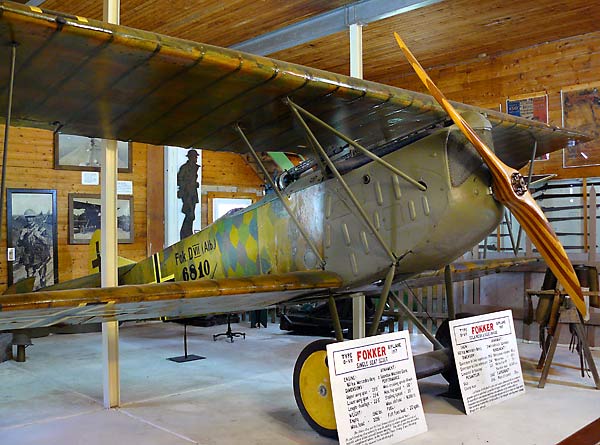
 |
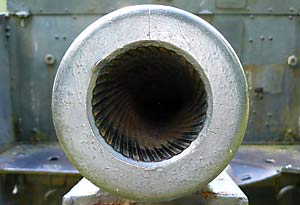 |
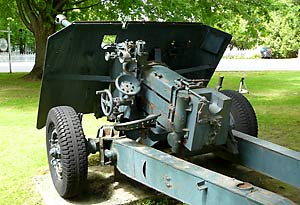 |
Brome County Museum Fokker D VII German WWI Biplane
Fokker DVII Specifications:
Length: 22 feet 3 inches
Wingspan: 29 feet, 3.5 inches
Height: 9 feet, 3 inches
Crew: 1
Weight: 1,540 lbs Empty 2,036 Max
Max Speed: 124 mph
Stall Speed: 55 mph
Cruise Speed: 110
Fuel Capacity: 20 gallons
Range: 1.5 hours endurance
Service Ceiling: 16,000 feet
Powerplant: Mercedes D III a Water Cooled Inline 6 - 180 hp
Armament: 2 7.92mm air cooled Spandau machine guns
First Flight : January, 1918
The Brome County Historical Society Museum is located less than an hour north from Richford, VT at 130 Lakeside in Knowlton Quebec.
As an aviation buff my main reason for making this trip was to see the museum's original Fokker D VII German Biplane from World War I. I had heard that this Fokker DVII was completely original, with its original fabric unrestored. According to the staff, after the war 22 examples of the Fokker D VII were brought to Canada in 1919 for study. The museum wrote to Ottawa asking for one example for their museum and after erecting a building for it one was sent out, the components said to be new in box. The shipping cost at the time was $112.50 Canadian dollars. Much of the Fokker D VII does look like new. Aside from some light surface rust on the propeller flange & nuts I can't see any corrosion on the airframe. From the looks of the engine block and inside of the exhaust pipe it doesn't appear the engine has ever been started. It really is remarkable and I was really excited to have the opportunity to see it up close (but most other aviation enthusiasts would feel the same). I spent a good amount of time looking it over and had the following observations:
The fabric is a puzzle. The common fabric seen on German WWI day fighters is a pre printed 4 color lozenge pattern, which you can see beneath the cockpit. However, this aircraft has at least 4 different patterns of fabric, and possibly a fifth.
The first is the standard 4 color green, blue, purple, and brown lozenge, seen under the cockpit, in on the inboard side of the lower LH wing's upper surface, and in patches under the tail.
The second is a lighter pattern on the undersides. It's a combination of light green, and other light earth tones. If I could take away all the yellowing of age there might be some cream or ivory colors. The lozenges are wider on this pattern and not quite as regular.
The third is a regular gray, green, earth, light green pattern that is more subdued than the first but darker than the undersides. I see this on the top of the fuselage, blending down the sides somewhat diagonally towards the tail.
The fourth is a medium green, light brown, tan and mustard pattern which is larger than the first and quite irregular. It includes smaller random shapes, some of a lighter blue. It's not clear if these were a part of the original fabric pattern or are patches applied afterwards. You can see this pattern most clearly on the top of the lower LH wing.
I'm not clear on the pattern on the Fokker D VII's top wing. It seems darker than the standard 4 color, and tighter than the fabric on the top of the fuselage. It appears to be mildewed (the building is neither heated nor air conditioned - if you've stored anything in a damp basement you can spot it right away) and possibly dusty/dirty on top of it. The lighting could be better. With those fluorescent tubes placed vertically alongside the fuselage it's difficult to make out with the naked eye, and with a camera with a good flash & lens hood you still can't throw enough light on it to bring out the pattern.
Looking at the engine, cowl, prop, and struts of the Fokker D VII I'd agree that this airframe is as new from factory. But the linen is a hodgepodge of different patterns of fabric. The upper side of the lower wing has 2 different fabric patterns with random patches here and there. On the fuselage sides is the standard darker pattern from the cockpit diagonally down and a light pattern above. Normally with aircraft camouflage the darker pattern is uppermost getting lighter towards the undersides. There is more patchwork on the fuselage beneath the tail. My guess is that the aircraft has either been repaired with large patches early in it's life, or it was quickly sewn together with whatever fabric was handiest from the factory. At some point the fabric has been varnished or shellacked. When these aircraft are covered with linen the fabric is sewn on and then dope is brushed on to shrink, tighten, and stiffen the fabric, then markings are painted on top of that. On the fuselage and lower wings I see a yellow sheen that reflects evenly even over the painted markings, so I believe it was applied later over everything, probably a well meaning attempt to preserve or improve its appearance.
------------------
1/27/2008 - Bill Glasgow from Scotland wrote with some more insight regarding the varying fabric patterns. Bill said he gleaned this info from Albatros Publications 'Fokker DV11 Anthologies:
"The mix of fabric is interesting. Apparently in 1963 the aircraft was moved from Knowlton to RCAF base Trenton where parts of the damaged fabric were patched with 'recreated' fabric supplied by the National Air and Space Museum of the Smithsonian Institution in Washington. This recreated 4 color fabric is known as the 'Knowlton pattern'. After the 1963 Ottawa RCAF Show the aircraft was moved back to Knowlton. Although completely original, the aircraft has components from several other aircraft fitted e.g. cowl, ailerons, tailplane and elevator which can be determined from the different aircraft identification numbers 6810, 8504, 8502, 6506 and 8318. This was common practice for these aircraft in service. "
------------------
There are a number of tears and holes in the linen covering. In my mind they make it more interesting as they show this has not been cosmetically restored. The mannequin has been placed in an attempt to hide a tear in the LH side of the fuselage. What would be even more interesting is if the tear were in plain view, and an explanation elsewhere of how each tear occurred. Even if it was due to janitor Elmer DePue slipping while mopping the floor in 1923. The tears are a part of the plane's history and each have a small story to tell.
I noticed the Fokker D VII's propeller was rather large and at such an angle that if one tried to hand prop it to start the engine there was no safe way to get out of the path of the descending blade in time. Initially I thought the hole in the upper RH side of the cowling was for an inertial starting handle. After doing some more research I've found that is not the case, and the starting procedure for these engines is really quite interesting. Each cylinder has a priming cup at the top. Before starting a mechanic squirts a mixture of gasoline and benzene into each cup. With the magneto switched off the mechanic rotates the prop by hand for 6 complete revolutions in order to draw the priming mixture into each cylinder. The pilot then switches on fuel and magnetos and proceeds to rapidly crank a handle in the lower right of the cockpit turning a starter magneto which I was not able to photograph. This sends a shower of sparks to the plug on the cylinder just past Top Dead Center and hopefully pushes the piston down and starts the engine turning. The next should fire after it passes TDC and if all is well it should continue firing till all cylinders are firing evenly.
The experience of seeing an original Fokker D VII for me personally was fantastic. I did feel though that there were a few things that could have been improved on. The lighting could have been better, there's not a lot of room around the aircraft, and some of the objects and exhibits next to to it obstruct the view of some details. There is also some glare to deal with. There could be soft floods high and in the corners which should not cast shadows as visitors view the aircraft. The room is not much larger than the aircraft itself, so getting a wide view is a challenge. A mannequin blocks the left side of the fuselage, a TV blocked the best vantage point of a wide view of the RH side, and two large signs completely obscure the undercarriage. Since I'd traveled almost 400 miles to get there I asked the staff if I could help move the signs, mannequin on its dolly, and TV for a few minutes for photographs before replacing them. Since the TV was not being used the staff did agree to move it, but they did not want to disturb the signs or mannequin. I'm sorry for the clutter in the photographs, but I did the best I could.
Here is a link to a page on the Canada Aviation and Space Museum's website with period photos of the Knowlton Fokker D.VII. I'm not sure what year they were taken, but I suspect it was sometime in the early 1920s.
The Brome County Historical Society Museum is small and the tours are unguided but the staff is friendly and eager to field your questions. There is no food on site but there are a number of restaurants just a short walk away. The museum has a fair amount of other artifacts, mainly early Canadian household, store, post office, and factory items, horse saddles & riding gear, and a good deal more that escapes me. The museum does not have it's own website but the Townships Heritage Webmagazine does have a page with hours and entry fee details. If you're interested in WWI military aircraft, make it a point to pay them a visit if you're in the area. Having an opportunity to see a real Fokker D VII was a big thrill.
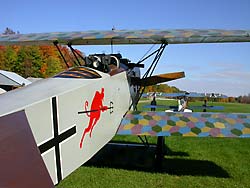 |
A working flying reproduction of a WWI German Fokker D. VII biplane can be found at The Old Rhinebeck Aerodrome in Rhinebeck, NY |
| Another excellent reproduction of a Fokker DVII can be found in The Early Years of Aviation Gallery at the US Air Force Museum in Dayton, OH | 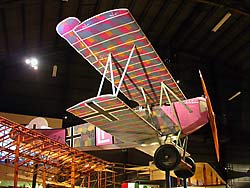 |
